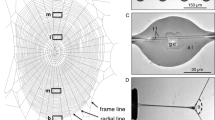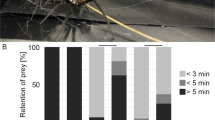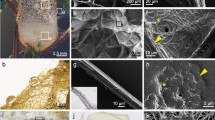Abstract
THE orb web of the garden spider Araneus diadematus, like those of other ecribellate orb spiders, relies on the remarkable extensibility of its sticky capture spiral to intercept and entrap prey1,2. The spiral strands consist of core fibres and an all-enveloping aqueous coat, which forms into a pattern of droplets3. The core fibres are paired and probably made of typical spider silk4,5. The aqueous solution droplets are more or less evenly spaced6 and are required to allow the special mode of extension of the fibres3,7. Knowledge of the chemical composition and general physical properties of this liquid phase is necessary to understand its function in web mechanics and prey capture8. We have now investigated the chemical composition of this aqueous solution and found the droplets to be a concentrated solution of hygroscopic substances related to neurotransmitters. We offer an explanation as to the function and origin of this solution.
This is a preview of subscription content, access via your institution
Access options
Subscribe to this journal
Receive 51 print issues and online access
$199.00 per year
only $3.90 per issue
Buy this article
- Purchase on Springer Link
- Instant access to full article PDF
Prices may be subject to local taxes which are calculated during checkout
Similar content being viewed by others
References
Gosline, J. M., DeMont, M. E. & Denny, M. W. Endeavour 10, 37–43 (1986).
Craig, C. L. Biol. J. Linn. Soc. Lond. 30, 135–163 (1987).
Vollrath, F. & Edmonds, D. T. Nature 340, 305–307 (1989).
Tillinghast, E. K. & Townley, M. in Ecophysiology of Spiders (ed. Nentwig, W.) 203–210 (Springer, Heidelberg, 1987).
Kovoor, J. in Ecophysiology of Spiders (ed. Nentwig, W.) 160–186 (Springer, Heidelberg, 1987).
Peters, H. M. in Ecophysiology of Spiders (ed. Nentwig, W.) 187–202 (Springer, Heidelberg, 1987).
Gosline, J. M., Denny, M. W. & DeMont, M. E. Nature 309, 551–552 (1984).
Calvert, P. Nature 340, 266 (1989).
Tillinghast, E. K. Insect Biochem. 14, 115–120 (1984).
Anderson, C. M. & Tillinghast, E. K. Physiol. Entomol. 5, 101–106 (1980).
Tillinghast, E. K., Huxtable, R. J., Watson III, W. H. & Townley, M. A. Comp. Biochem. Physiol. 888, 457–460 (1987).
Tillinghast, E. K. & Christenson, T. J. Arachnol. 12, 69–74 (1984).
Fischer, F. G. & Brander, J. Hoppe-Seyler's Z. Physiol. Chem. 320, 92–102 (1960).
Schildknecht, H., Kunzelmann, O., Krauss, D. & Kuhn, C. Naturwissenschaften 59, 98–99 (1972).
Tillinghast, E. K. Naturwissenschaften 68, 526–527 (1981).
Kovoor, J. & Zylberberg, L. Zoomorphology 92, 217–239 (1979).
Rayleigh (Lord), Phil. Mag. 34, 145–154 (1982).
Thompson, D'Arcy W. in Growth and Form (ed. Bronner, J. T.) 49–87 (Cambridge University Press, 1961).
Brawn, A. D. Bact. Rev. 40, 803–846 (1976).
Yancey, P. H., Clark, M. E., Hand, S. C., Bowlus, R. D. & Somero, G. N. Science 217, 1214–1222 (1982).
LeRudulier, D., Storm, A. R., Dandekar, A. M., Smith, L. T. & Valentine, R. C. Science 224, 1064–1068 (1984).
Somero, G. N. Am. J. Physiol. 251, R197–R213 (1986).
Truper, H. G. & Galinski, E. A. Experientia 42, 1182–1187 (1986).
Measures, J. C. Nature 257, 398–400 (1975).
Schultz, J. W. Biol. Rev. 62, 89–113 (1987).
Coddington, J. A. J. Arachnol. 17, 71–95 (1989).
Selden, P. A. Nature 340, 711–713 (1989).
Shear, W. A., Palmer, J. M., Coddington, J. A. & Bonamo, P. M. Science 246, 479–481 (1989).
Witt, P. N., Reed, C. F. & Peakall, D. B. in A Spider's Web (Springer, Heidelberg, 1968).
Meyer, W., Schlesinger, Ch., Poehling, H. M. & Ruge, W. Comp. Biochem. Physiol. 78C, 357–362 (1984).
Babu, K. S. Zool. Jb. Anat. 82, 1–154 (1965).
Babu, K. S. in Neurobiology of Arachnids (ed. Barth, F. G.) 3–19 (Springer, Heidelberg, 1985).
Aue, W. P., Bartholdi, E. & Ernst, R. R. J. chem. Phys. 64, 2229–2246 (1976).
Tillinghast, E. K. & Kavanagh, E. J. J. exp. Zool. 202, 213–222 (1977).
Solomon, M. E. Bull. ent. Res. 42, 543–554 (1951).
Winston, P. W. & Bates, D. H. Ecology 41, 232–237 (1960).
Author information
Authors and Affiliations
Rights and permissions
About this article
Cite this article
Vollrath, F., Fairbrother, W., Williams, R. et al. Compounds in the droplets of the orb spider's viscid spiral. Nature 345, 526–528 (1990). https://doi.org/10.1038/345526a0
Received:
Accepted:
Issue Date:
DOI: https://doi.org/10.1038/345526a0
This article is cited by
-
The evolutionary history of cribellate orb-weaver capture thread spidroins
BMC Ecology and Evolution (2022)
-
Spidroin profiling of cribellate spiders provides insight into the evolution of spider prey capture strategies
Scientific Reports (2020)
-
Orb-weaving spider Araneus ventricosus genome elucidates the spidroin gene catalogue
Scientific Reports (2019)
-
Biomechanical properties of fishing lines of the glowworm Arachnocampa luminosa (Diptera; Keroplatidae)
Scientific Reports (2019)
-
Silk: A Promising Biomaterial Opening New Vistas Towards Affordable Healthcare Solutions
Journal of the Indian Institute of Science (2019)
Comments
By submitting a comment you agree to abide by our Terms and Community Guidelines. If you find something abusive or that does not comply with our terms or guidelines please flag it as inappropriate.



